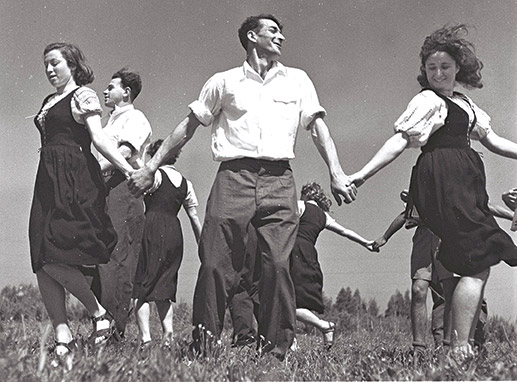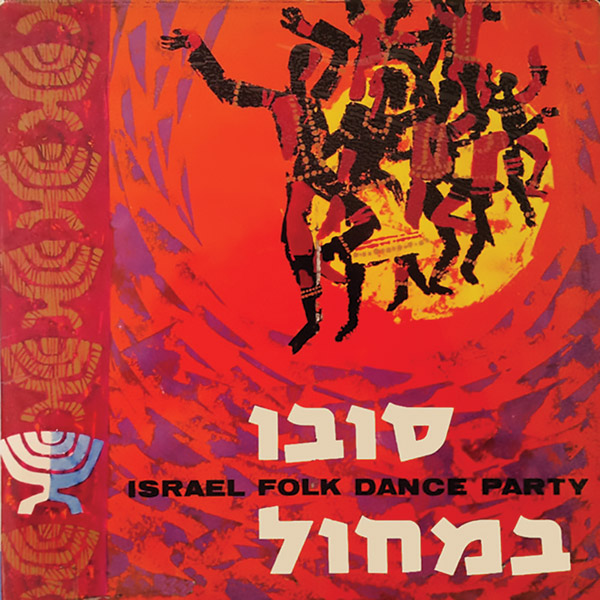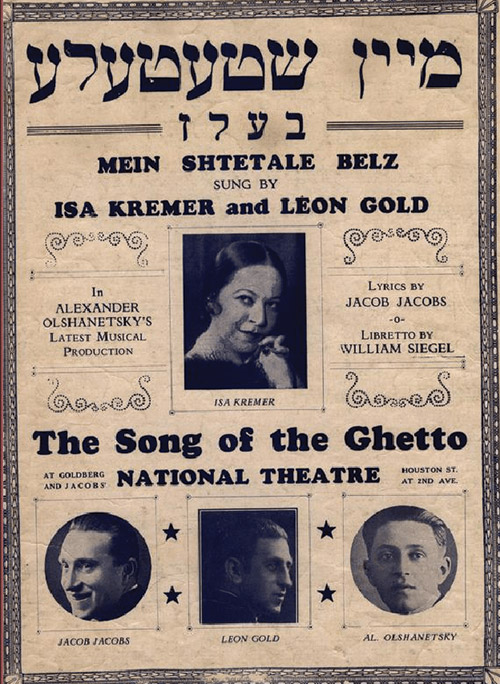From the Shtiebel to the Hora
More than two hundred songs of the Third Aliyah’s pioneers—the heart of the secular Zionist musical repertoire—began their lives as Hasidic tunes. Historian David Assaf’s wonderful new book reaches far beyond the Hasidic—and even the Jewish—world in tracing the origins of Israeli songs, but some of its most entrancing pages trace the movements of niggunim from their original religious settings to secular ones, only to return, on occasion, someplace closer to home. And it turns out that it wasn’t necessarily that much of a leap from the shtiebel to the hora. (Several versions of most of the songs discussed by Assaf appear on an accompanying website, and you can access it at bit.ly/shirhulo.)
Take, for example, “Rav ha-laila” (The Night Is Mighty), a contagious song about raucous dancing that made its way into American Zionist camps as well as the scores for the movies Exodus (1960), Cast a Giant Shadow (1966), and, more recently, The Little Traitor (2007). In the last two of these films, it’s the music to which Jews dance in the streets of Tel Aviv after the United Nations votes to partition Palestine (“For our hearts are one heart, forever and ever”). The song was less than twenty years old in 1947, but the niggun had been around for a lot longer.

The story of how the tune of “Rav ha-laila” made it from the synagogue to the streets begins with the poet, playwright, and songwriter Yaakov Orland, himself a crossover phenomenon. It would be easy to imagine that Orland was the renegade son of a pious Eastern European Jew who threw off the yoke of the commandments but brought the tune with him when he went to Palestine to become a pioneer. In fact, it was his pious father who was the pioneer. Eliezer Orland survived a bloody pogrom in Ukraine in 1921 and left for Palestine, settling in Jerusalem where—when he wasn’t building roads—he prayed with the Boyaner Hasidim on the edge of Meah Shearim.
Sometime between 1931 and 1933, Eliezer came home from humming a tune that wouldn’t let go of him. The teenaged Yaakov, who was already losing his faith but acquiring his skills, offered to fit some words to the niggun so his father could remember it better. And thus was born “Rav ha-laila,” which, Orland later wrote, “I felt was a kind of strengthening of the chain between the generations” of Jewish singers. The lyrics of his song, with their announcement that “od nimshekhet ha-sharsheret” (the chain still stretches on), make this connection explicit. The chain had some unexpected twists, however. In 1933, Moshe-Zvi Neria, a disciple of Rabbi Abraham Isaac Kook and one of the founders of Bnei Akiva, also wrote new lyrics for the tune, ones more in keeping with the spirit of his religious Zionist youth movement (“O brothers, let’s shout out, until we get to the Bnei Akiva kvutzah”).
The latest twist in the tune’s history has little to do with Zionism, secular or religious. In Israeli soccer stadiums, fans have put “aggressive, vulgar, and crude” words to the niggun, denouncing whoever happens to be their opponent. This doesn’t bring honor to the history of Hebrew song, says Assaf, but it’s part of the story of this tune, and so he tells it. And, he notes, anyone who has ever seen these overzealous fans knows that the fervor with which they sing in unison “is no less intense than the intoxication of the senses of the pioneers of the [Jezreel] valley, or the youthful fervor of the ‘knitted kippot,’ or the Hasidic spiritual exaltation at the time of the seudah shlishit (third Sabbath meal).”
“Hey Daromah!” (Southward Ho!)—another familiar song (to veterans of Hebrew-speaking summer camps, at any rate)—has roots in a more secular Jewish heritage, a Yiddish song entitled “Hey Dzhankoye!” Composed in the Soviet Union sometime before 1936, this song is about how Jews from devastated shtetls moved south to rebuild their lives on collective farms in Crimea (where Dzhankoye was situated). The folklorist Dov Noy translated it into Hebrew in Cyprus, to which he had come from Palestine in 1947 to teach the Jewish refugees who had been interned there by the British. Among the Holocaust survivors was his own brother Meir, whom he hadn’t seen since he left Europe in 1938. The brothers were still awaiting transfer to Israel at the end of 1948, when the great songwriter Haim Hefer visited together with the entertainment troupe of the Palmach and the IDF, the legendary Chizbatron. Hefer, who has a larger presence in Assaf’s book than just about anyone else, learned the Hebrew version of “Hey Dzhankoye!” from them.
A few months later, Hefer was in Beersheva as part of the force poised to liberate the Negev from Egyptian invaders. Inspired to write a song about the rush southward, he borrowed the tune from “Hey Dzhankoye!” That’s the version of “Hey Daromah!” that the Chizbatron practiced on the way south, but it’s not the tune we know now. After the battle was over, Meir Noy, who was by this time attached to the IDF’s entertainment unit, argued that such a great victory shouldn’t be commemorated with a Russian tune and promptly composed a new, vigorously thumping one. Hefer readily adopted it.
Sometimes the influence went the other way, from Palestine back to Russia. Yitzhak Shenhar’s wistful poem about hard work and dancing, “Kuma ekha” (Rise Up, Brother), was set to music shortly after it was written, in 1924 or 1925, by one of the founders of Kibbutz Ein Harod, Shalom Postolsky. (He also wrote the familiar tune of “Avadim Hayinu” that is often sung at our Seders.) “Kuma ekha” quickly became one of the most popular songs to which horas were danced. It inspired the creation of a new dance in 1937 that remains a favorite of Israeli folk dancers today. The year before that, however, the tune (but not the words) showed up in a Soviet film, Seekers of Happiness, about the supposed rejuvenation of the Jews on the collective farms of the Jewish Autonomous Region of Birobidzhan. A certain Isaak Dunayevsky took credit for composing the music to what was now called “The Song of the Jewish Komsomol.” How did the tune make its way through the sealed borders of the Soviet Union—as Assaf puts it, from Ein Harod to Birobidzhan?
According to the daughter of one of the actors in Seekers of Happiness, Dunayevsky learned the tune from one of the halutzim who left Ein Harod for the new Soviet Eden in the late 1920s. This seems plausible enough, but Assaf shoots the story down quickly and suggests a different route. Zinovyi Kompanietz, a Russian-born composer, settled in Tel Aviv in 1927 or 1928 and married an actress. In 1932, he returned with her to the Soviet Union, where he would claim, among other things, that the Yiddish song “Yidl mit’n fidl,” which was written in Poland in 1936, was originally a Soviet song. Dunayevsky, Assaf suggests, “picked up the tune from Kompanietz” in the Soviet Union.
Shir hu lo rak milim (A Song Is More than Words) is mainly about Hebrew songs, but Yiddish is rarely very far away. In fact, the first two chapters of the book, which are among the best, focus on two well-known Yiddish songs, “Oyfn pripetshik” (On the Hearth) and “Mayn shtetele Belz.” In the first of these chapters, Assaf seeks to explain, among other things, the massive popularity of the first of these songs, a tender reminiscence of the cheder, at the very time when some of the people who most enjoyed it were busy reviling the institution it celebrated.

Sholem Aleichem was a friend and enormous booster of the composer of “Oyfn pripetshik,” Mark Warshafsky (1848–1907). But how, Assaf wonders, could the great Yiddish author write a realistic story like “Boaz the Melamed,” in which a hard-hearted cheder teacher brutalizes his pupils, while being an enthusiastic promoter of a nostalgic song featuring a melamed who lovingly teaches his kids the “alef-beys”? The apparent contradiction, Assaf explains, expresses the ambivalence of many early twentieth-century secularists who had a traditional cheder education.
At that time, many of the writers and intellectuals who had already left the small town and religious tradition behind them and moved to big cities had a deep feeling in their hearts that the decline of the shtetl in which they had been raised was almost a fait accompli.
They also felt a certain longing for some old-world institutions, which they had come to perceive as bulwarks against assimilation despite all their failings. Assaf writes that “those who sang the song with fervor even though their way of life was far from that of the old cheder” gave the institution a measure of respect that it had never enjoyed in historical reality. The fire in the hearth that warmed the rebbe and his little pupils became “not just a symbolic expression of the warmth of tradition but a representation of the stubborn, eternal fire in the Jewish soul that thousands of winds and calamities will never be able to snuff out.”
This is the heart of the matter, but it’s only a part of the story. Assaf tells us where “Oyfn pripetshik” comes from—not just fond memories but a mid-nineteenth-century French song that depicts a teacher sitting on a stump in a glade, teaching his pupils the alphabet—and where it very quickly went: Tel Aviv, where a Hebrew version likewise takes the children outdoors and focuses more on planting trees than learning one’s letters. The chapter concludes with gruesome Holocaust-era spin-offs of the song, in one of which a fire at the ghetto’s gate replaces the fire on the hearth, and “yidelekh” returning from a day of slave labor take the place of the cheder children.
The question in the chapter on “Mayn shtetele Belz” is, which Belz? The most likely candidate would seem to be the town in East Galicia that was the home of the Belzer Hasidim and whose postwar yizkhor book proudly displays the song’s lyrics in its opening pages. The other candidate is Beltsy in Bessarabia, whose yizkhor book also reprints the song—even though it wasn’t a shtetl at all but a smallish city. Who’s right? The song, which is almost unbelievably soppy (“Belz, my little town of Belz / The little house where / I spent my childhood! / Belz, my little town of Belz / The poor little room, / where I used to laugh with other children”), was composed for an operetta called The Song of the Ghetto, which was first performed on Second Avenue in 1932. The lyrics were the work of Jacob Jacobs (better known for writing the words of the 1930s crossover hit “Bei mir bist du shayn”). Jacobs was from Hungary, the playwright was Lithuanian, and the man who wrote the music was from Odessa. So why did they choose Belz? As an appreciative gesture to the show’s two stars, Isa Kremer and Leon Gold, both from Beltsy.

Naturally, Assaf tells their stories too. Kremer was a small woman fond of large jewelry, a beautiful charmer who captivated everyone from Sholem Aleichem and Vladimir Jabotinsky (who had heard her in Odessa) to Albert Einstein (in whose Berlin home she held a concert). After starting out in the opera, she switched to Eastern European folk songs. Her early repertoire included songs in seven different languages. Her husband’s friend, the poet Chaim Nachman Bialik, then convinced her to focus on Yiddish. In 1922, she came to America, where she stayed for sixteen years before migrating to Argentina. Leon Gold was an actor and a Red Army veteran who came to the United States in 1924, settled on the Lower East Side, and worked on the Yiddish stage. In 1947, after he tired of the theater, he became a cantor in a town outside of Boston.
“Mayn shtetele Belz” had a life no less colorful than the movie’s actors. It was never a worldwide hit on the scale of “Bei mir bist du shayn,” but it did make its way to Poland, where a Polish-language version was popular among Gentiles as well as Jews. A reporter for Ha-doar even complained that you could hear the sounds of Miasteczko Belz drifting from the balconies of every apartment in Tel Aviv.
That was in 1936. A few years later, disaster struck. Assaf writes:
There are many testimonies that German soldiers ordered Jews to sing “Mayn shtetele Belz” as a part of “games” of humiliation and abuse. In August 1944, Eliezer Unger, a young man in his thirties, testified how three years earlier, in November 1941, German and Ukrainian rioters abused the Jews of Lvov who were forced into the ghetto: “the rioters mocked the women who were in transit, stripped them naked and ordered them to dance and to sing ‘Mayn shtetele Belz.’ The voices and the cries of the tortured mingled with the wild voices of the torturers and pierced the air.”
It would be wrong to end a review of such a joyous book on such a tragic note. Shir hu lo rak milim is less about the sorrows of the Jews than the irrepressible vitality of modern Jewish life. Nowhere is this more evident than in Assaf’s pages on Haim Hefer. Hefer wrote his very first song, “Bein gevulot” (Between Borders), between 1944 and 1945 when he was serving with the Palmach, smuggling refugees across the Syrian border into Palestine. Set to the tune of a Russian march, the song’s words promise the wounded and the elderly traveling through the hills toward their homeland a chomat magen, a “defensive shield.” (If that phrase sounds familiar, it’s probably because the IDF chose it as the name for the large-scale antiterrorist operation on the West Bank during the Second Intifada in 2002.)
In the mid-1950s, Hefer wrote another song, one about the less-than-ideal life that took place behind that original defensive shield. Entitled “Ein k’mo Yafo ba-leilot” (There’s Nothing Like Jaffa at Night), it sketches the marginal lives of a multiethnic crowd of new Jewish immigrants in the slums of the formerly Arab city. Flashy women with lipstick the color of blood parade by a gang that includes Chico the driver, Moyshe Ganiff the glazier, Eli Poker the card sharp, and a sycophantic policeman—all of whom ultimately end up in jail for bank robbery. It’s not a pretty picture, as Assaf observes, but it’s a rollicking scene—and song. I learned it (sort of) as an adolescent, thanks to my aunt and uncle, who brought back a record of the Ha-Tarnigolim (The Roosters) for me from their 1964 trip to Israel. I could only understand a few of Hefer’s lyrics, but I still loved listening to the song, which made me feel like I was at the circus.
A song is, as Assaf shows again and again, more than its lyrics. And his beautiful book is about more than songs; it’s an eye- and ear-opening tour of modern Jewish history. In the introduction, he tells us that he’s got enough material for a second book. I hope he writes it soon—in the meantime, I’ll continue to read his weekly blog (Oneg Shabbat), where much of the material in this book first appeared in a kind of public first draft. I recommend the blog to all who can read Hebrew, and for those who cannot, I hope that a translation of his utterly remarkable book will soon be available.
Comments
You must log in to comment Log In
Suggested Reading
Lands of the Free
It is sad to watch the territorialists engage in their wild goose chases all over the globe at a time when multitudes of Jews were in need of a place, any place, to go.

New Beats for Old Brooklyn
Andy Statman started out as an unlikely prodigy: a New York Jewish kid playing bluegrass on the mandolin.
Haim Gouri at 90
The poet turned 90 last fall, and his latest poems are among the best he has ever written.
Darkness and Light: Leonard Cohen and the New Cantors—A Playlist for the High Holidays
Old World Ashkenazi cantorial art—khazones—is making a comeback, with a surprising little boost from Leonard Cohen's new single (yes, that Leonard Cohen).
Ilan Troen
What a wonderful review! Thanks for bringing this book to my attention. I have long been fascinated by the somewhat ironical creation of "folk songs" in the Yishuv. By definition, such songs have deep roots and are composed by anonymous writers. That was hardly the case. Jehoash Hirshberg's "Music in the Jewish Community in Palestine, 1880-1948 (Oxford, 1995), 78-109, 147-48, notes that nearly 200 composers produced more than 4,000 Hebrew folk songs through 1948, many in the 1920s. The roots can be ascribed to the Society for Jewish Music (est. St. Petersburg in 1908), and then Berlin and ultimately the Yishuv. It is a wonderful example of Hobsbawn's "invented tradition."